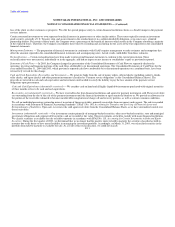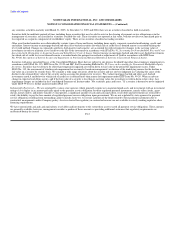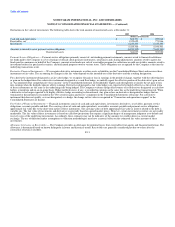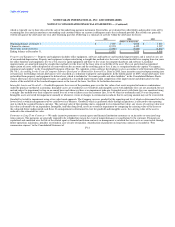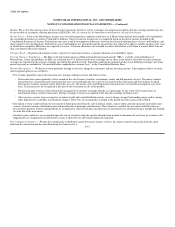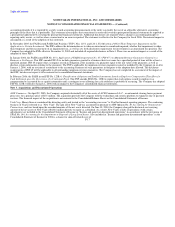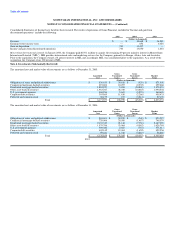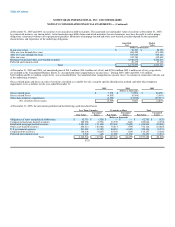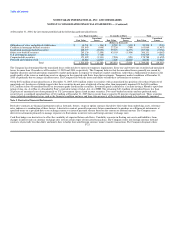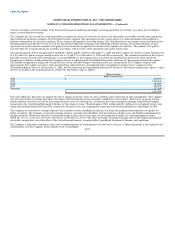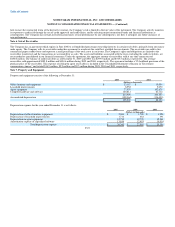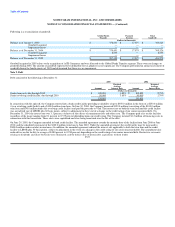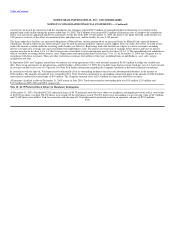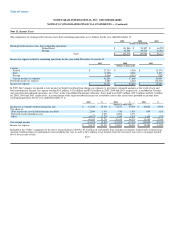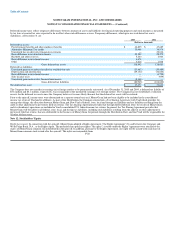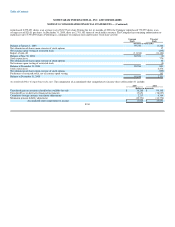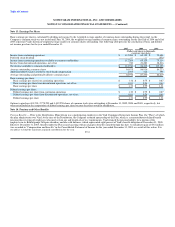MoneyGram 2005 Annual Report Download - page 75
Download and view the complete annual report
Please find page 75 of the 2005 MoneyGram annual report below. You can navigate through the pages in the report by either clicking on the pages listed below, or by using the keyword search tool below to find specific information within the annual report.
Table of Contents
MONEYGRAM INTERNATIONAL, INC. AND SUBSIDIARIES
NOTES TO CONSOLIDATED FINANCIAL STATEMENTS — (Continued)
At December 31, 2004, the investment portfolio had the following aged unrealized losses:
Less Than 12 months 12 months or More Total
Unrealized Unrealized Unrealized
Fair Value Losses Fair Value Losses Fair Value Losses
(Dollars in thousands)
Obligations of states and political subdivisions $ 14,749 $ (136) $ 8,789 $ (113) $ 23,538 $ (249)
Commercial mortgage-backed securities 135,843 (698) 27,226 (789) 163,069 (1,487)
Residential mortgage-backed securities 808,377 (5,879) 99,325 (1,477) 907,702 (7,356)
Other asset-backed securities 263,136 (2,558) 43,195 (1,504) 306,331 (4,062)
U.S. government agencies 106,769 (718) — — 106,769 (718)
Corporate debt securities 171,492 (1,331) 7,296 (321) 178,788 (1,652)
Preferred and common stock 15,884 (1,063) 7,200 (2,800) 23,084 (3,863)
Total $ 1,516,250 $ (12,383) $ 193,031 $ (7,004) $ 1,709,281 $ (19,387)
The Company has determined that the unrealized losses reflected above represent temporary impairments. Sixty-one and twenty-one securities had unrealized
losses for more than 12 months as of December 31, 2005 and 2004, respectively. The Company believes that the unrealized losses generally are caused by
liquidity discounts and risk premiums required by market participants in response to temporary market conditions, rather than a fundamental weakness in the
credit quality of the issuer or underlying assets or changes in the expected cash flows from the investments. Temporary market conditions at December 31,
2005 are primarily due to changes in interest rates. The Company has both the intent and ability to hold these investments to maturity.
Of the $45.2 million of unrealized losses at December 31, 2005, $43.6 million relates to securities with an unrealized loss position of less than 20 percent of
amortized cost, the degree of which suggests that these securities do not pose a high risk of being other than temporarily impaired. Of the $43.6 million,
$33.2 million relates to unrealized losses on investment grade fixed income securities. Investment grade is defined as a security having a Moody's equivalent
rating of Aaa, Aa, A or Baa or a Standard & Poor's equivalent rating of AAA, AA, A or BBB. The remaining $10.4 million of unrealized losses less than
20 percent of amortized cost relates primarily to U.S. government agency fixed income securities. Two asset-backed securities and one preferred stock
security have a combined unrealized loss of $1.6 million at December 31, 2005 that is greater than or equal to 20 percent of amortized cost. These securities
were evaluated considering factors such as the financial condition and near and long-term prospects of the issuer and deemed to be temporarily impaired.
Note 5. Derivative Financial Instruments
Derivative contracts are financial instruments such as forwards, futures, swaps or option contracts that derive their value from underlying assets, reference
rates, indices or a combination of these factors. A derivative contract generally represents future commitments to purchase or sell financial instruments at
specified terms on a specified date or to exchange currency or interest payment streams based on the contract or notional amount. The Company uses
derivative instruments primarily to manage exposures to fluctuations in interest rates and foreign currency exchange rates.
Cash flow hedges use derivatives to offset the variability of expected future cash flows. Variability can arise in floating rate assets and liabilities, from
changes in interest rates or currency exchange rates or from certain types of forecasted transactions. The Company enters into foreign currency forward
contracts of generally less than thirty and ninety days to hedge forecasted foreign currency money transfer transactions. The Company designates these
F-21


